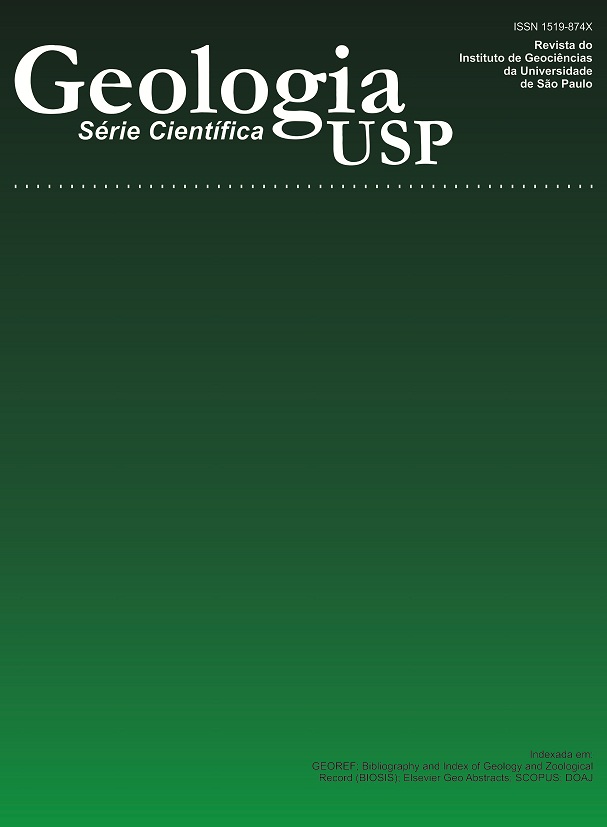Mineral chemistry of paleoproterozoic volcano-plutonism from the São Félix do Xingu (PA) region, Amazonian Craton
DOI:
https://doi.org/10.5327/Z1519-874X201400010007Abstract
The Sobreiro and Santa Rosa formations are result of large paleoproterozoic volcanic activities in the São Félix do Xingu (PA) region, SE of Amazonian Craton. The Sobreiro Formation is composed of andesitic lava flow facies, with subordinate dacite and rhyodacite, and autoclastic volcaniclastic facies characterized by tuff, lapilli-tuff, and massive polymictic breccia. These rocks exhibit clinopyroxene, amphibole, and plagioclase phenocrysts in a microlytic or trachytic groundmass. The clinopyroxene is augite with subordinate diopside, and reveals chemical variations typical of minerals generated by arc-related magmatism. The amphibole is magnesiohastingsite, has oscillatory oxidizing conditions, and reveals breakdown rim textures linked to degassing during magma ascent. The Santa Rosa Formation has polyphase evolution controlled by large NE-SW crustal fissures, materialized by rhyolitic and dacitic lava flow facies. Volcaniclastic facies of ignimbrites, lapilli-tuffs, felsic crystal tuffs, and massive polymict breccias represents an explosive cycle in this unit. Metric dikes and stocks of granitic porphyries and equigranular granitoids complete this suite. K-feldspar, plagioclase, and quartz phenocrysts surrounded by quartz and K-feldspar integrowth occur in these rocks. Electron microprobe pressure and temperature estimates in clinopyroxene phenocrysts reveal formation depth between 58 and 17.5 km (17.5 - 4.5 kbar) at temperatures between 1,249 and 1,082 ºC; and between 28 and 15 km (7.8 - 4.1 kbar) for amphibole grains of the Sobreiro Formation, suggesting polybaric evolution. A model with generation of hydrated basaltic magma from partial melting of mantle wedge and accumulation in a hot zone of the lower crust, from which the andesitic and dacitic magmas are formed by the assimilation of continental crust and following fractional crystallization is proposed.Downloads
Download data is not yet available.
Downloads
Published
2014-03-01
Issue
Section
Articles
License
Authors who publish in this journal shall comply with the following terms:
- Authors keep their copyright and grant to Geologia USP: Série Científica the right of first publication, with the paper under the Creative Commons BY-NC-SA license (summary of the license: https://creativecommons.org/licenses/by-nc-sa/4.0 | full text of the license: https://creativecommons.org/licenses/by-nc-sa/4.0/legalcode) that allows the non-commercial sharing of the paper and granting the proper copyrights of the first publication in this journal.
- Authors are authorized to take additional contracts separately, for non-exclusive distribution of the version of the paper published in this journal (publish in institutional repository or as a book chapter), granting the proper copyrights of first publication in this journal.
- Authors are allowed and encouraged to publish and distribute their paper online (in institutional repositories or their personal page) at any point before or during the editorial process, since this can generate productive changes as well as increase the impact and citation of the published paper (See The effect of Open Access and downloads on citation impact).
How to Cite
Cruz, R. S. da, Fernandes, C. M. D., Juliani, C., Lagler, B., Misas, C. M. E., Nascimento, T. de S., & Jesus, A. J. C. de. (2014). Mineral chemistry of paleoproterozoic volcano-plutonism from the São Félix do Xingu (PA) region, Amazonian Craton . Geologia USP. Série Científica, 14(1), 97-116. https://doi.org/10.5327/Z1519-874X201400010007





